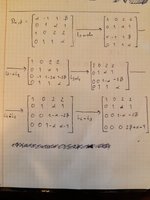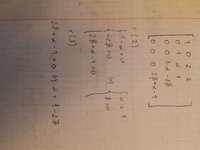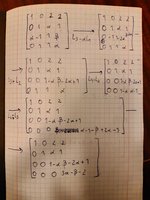I'm struggling with this exercise:
Find the possible ranks of the matrix D, depending on the values of a and b.
\(\displaystyle D_{a,b} = \begin{bmatrix}a & -1 & 1 & b \\0 & 1 & a & 1 \\1 & 0 & 2 & 2 \\0 & 1 & 1 & a\end{bmatrix}\)
After reducing D to row echelon form I got:
\(\displaystyle \begin{bmatrix}1 & 0& 2& 2 \\0 & 1 & a & 1\\0& 0 & 1-a& b-2a+1\\0 & 0& 0& b-a\end{bmatrix}\)
Based on this I concluded that if \(\displaystyle a = 1 \) and \(\displaystyle b = 1 \) then \(\displaystyle r(D) = 2 \); If \(\displaystyle a = b \) and \(\displaystyle a,b \neq 1 \) then \(\displaystyle r(D) = 3 \).
Apparently this is incorrect according to the solutions in the book, and I can't really understand why.
Find the possible ranks of the matrix D, depending on the values of a and b.
\(\displaystyle D_{a,b} = \begin{bmatrix}a & -1 & 1 & b \\0 & 1 & a & 1 \\1 & 0 & 2 & 2 \\0 & 1 & 1 & a\end{bmatrix}\)
After reducing D to row echelon form I got:
\(\displaystyle \begin{bmatrix}1 & 0& 2& 2 \\0 & 1 & a & 1\\0& 0 & 1-a& b-2a+1\\0 & 0& 0& b-a\end{bmatrix}\)
Based on this I concluded that if \(\displaystyle a = 1 \) and \(\displaystyle b = 1 \) then \(\displaystyle r(D) = 2 \); If \(\displaystyle a = b \) and \(\displaystyle a,b \neq 1 \) then \(\displaystyle r(D) = 3 \).
Apparently this is incorrect according to the solutions in the book, and I can't really understand why.
Last edited:





